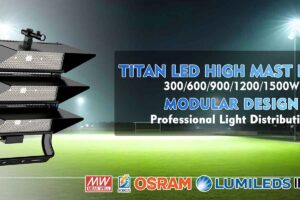Nowadays, LED sports lighting has been more and more widely used for football field lighting facilities due to its high value of energy efficiency in installations, as well as the directional nature of their emissions. They achieve energy savings of up to 80% compared with traditional Metal Halide luminaires. Furthermore, also considering the substantial decrease in flickers, and that it noticeably improves usage of ultra-slow-motion cameras and the fading of switching-on or rearm times upon failure, LED football field lighting stands out as the main solution for illumination of professional sports facilities.
When it comes to sports field lighting in specific, there are a number of requirements that need to be considered. These are dependent on the level of competition that will take place on the pitch and the related standards for lighting levels and lighting uniformity. Football governing bodies at the national and international level provide guidance on what the club needs to ensure its football floodlights meet the necessary standards for safety and performance. Let’s take a look at UEFA regulations here:
Table of Contents
a.
The light temperature should be between 4000K and 6000K.
b.
The football field lighting system inside the stadium must be installed in a way to minimize the intensity of the players’ shadows cast on the field, to get the best result it’s recommended to distribute the origin of the luminous flux uniformly on all the field sides, if such installation isn’t possible, the luminous flux will still have to come from at least two directions, considering that the source located behind the cameras should never exceed 60% of the total projected light. The football field lights should be placed high enough to prevent horizontal dazzling, the headlights must direct the luminous flux on the playground, to ensure maximum system yield and minimize the light pollution outwards.
c.
It’s recommended an illumination system that allows the light intensity control, in order to adapt it to different needs (match, training, post-game cleaning, etc…) and obtain a flexible and suited light, rationalizing the use of energy resulting in a cost-cutting.
d.
In case of the football field lighting power failure, it must be provided an emergency lighting system to ensure the television coverage continuity, with 800 lux minimum illumination for fixed cameras and 500 lux for the mobile, and an emergency stands system of at least 25 lux on average for the spectators’ safety.

Minimum illumination values required according to the UEFA standards for football field lighting
If you have any questions about LED sports lighting, welcome to contact us directly.




Leave a Reply
Your email is safe with us.